
AI-driven workflows are transforming businesses, but they also introduce new security risks. Choosing the right security orchestration platform is essential to protect sensitive data, automate responses, and meet compliance standards. Here's a quick overview of the top solutions:
| Platform | Key Strengths | Compliance Focus | Automation Features | Cost Management |
|---|---|---|---|---|
| Cortex XSOAR | Seamless integration, scalable architecture | SOC 2, GDPR | Pre-built workflows, minimal manual input | Traditional pricing |
| Splunk SOAR | Broad third-party tool integration | Industry standards | Playbook engine, real-time threat response | Bundled pricing |
| Microsoft Sentinel | Native Azure integration, AI-driven insights | GDPR, PII protections | Advanced playbooks, AI correlation | Azure-based pricing |
| Fortinet FortiSOAR | Threat intelligence, zero-trust model | SOC 2, ISO 27001, GDPR | Visual workflow designer, pre-built playbooks | Traditional pricing |
| Sumo Logic Cloud SOAR | Cloud-native flexibility, centralized tools | Role-based access control | Visual playbook editor, automated enrichment | Subscription-based pricing |
| Prompts.ai | Unified AI workflows, TOKN credits system | Centralized governance | Time Savers, prompt workflows | Pay-As-You-Go TOKN credits |
Each platform offers unique advantages. For AI-focused governance and cost savings, Prompts.ai stands out with its unified interface and transparent pricing. For broader security orchestration, platforms like Cortex XSOAR and Splunk SOAR excel. Select based on your organization's needs, compliance requirements, and budget.
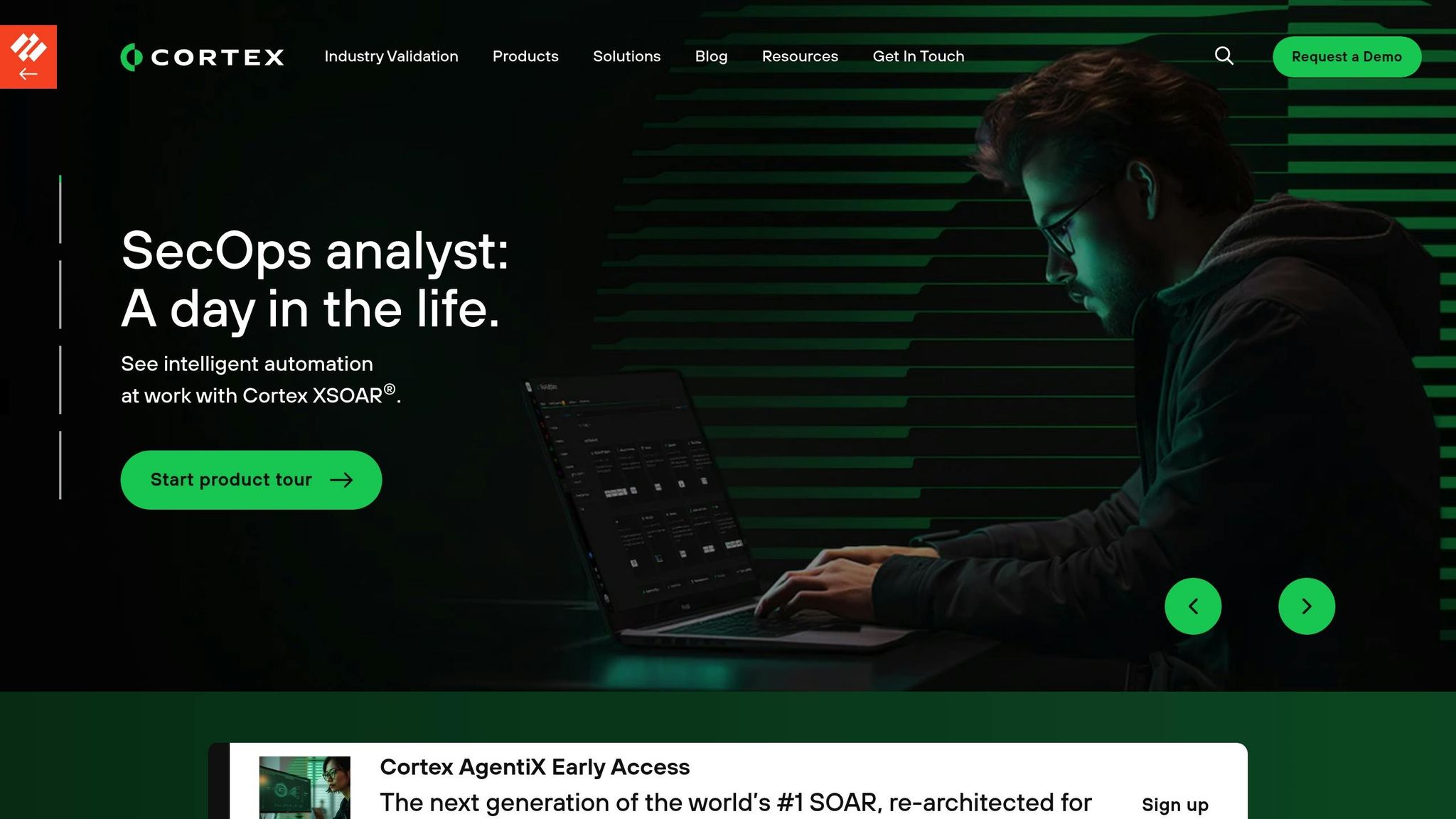
Cortex XSOAR by Palo Alto Networks stands out as a top-tier SOAR platform, earning a solid 4.6/5 rating on Gartner Peer Insights. Its strength lies in seamless integration with enterprise security systems.
Built with Palo Alto Networks' expertise, Cortex XSOAR delivers comprehensive protection across clouds, networks, and mobile devices.
Cortex XSOAR connects effortlessly with a wide range of security technologies, acting as a bridge between secure outcomes and custom tools. It features pre-built integrations with third-party solutions, enabling real-time data sharing and streamlining security operations. This robust connectivity lays the groundwork for smooth automation across workflows.
By automating complex tasks, Cortex XSOAR enhances productivity for security analysts. Its orchestration of AI-driven models allows for the execution of advanced security operations with minimal manual intervention.
Cortex XSOAR’s flexible architecture and growing integration capabilities adapt to meet the needs of expanding enterprises, ensuring it remains a valuable solution as organizations evolve.
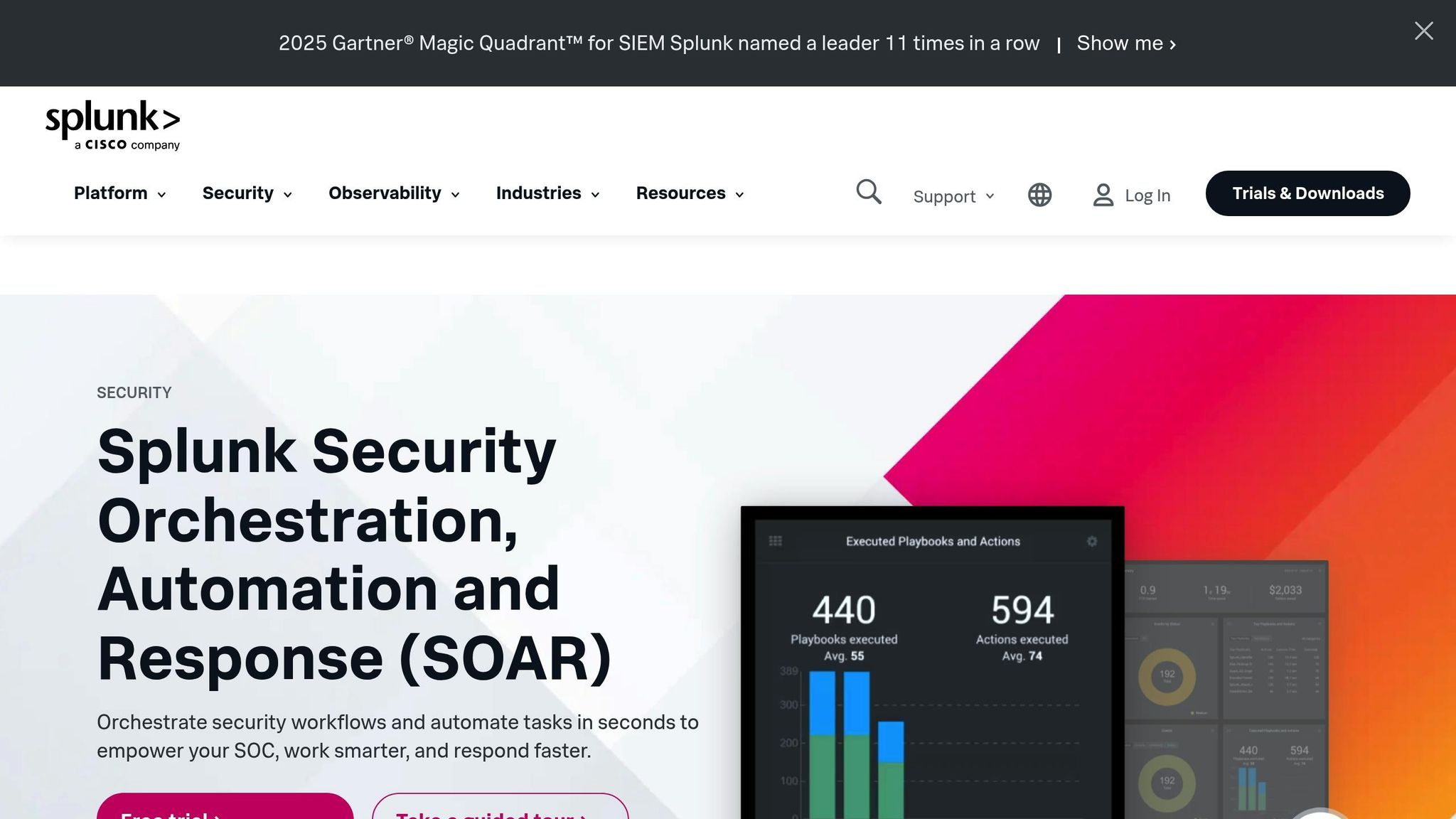
Splunk SOAR (Security Orchestration, Automation, and Response) is a platform designed to streamline incident response by automating processes and managing threats effectively.
To protect sensitive information, Splunk SOAR employs role-based access controls and encrypted data transmission. Its secure architecture ensures compliance with industry standards, while detailed logs of automated actions provide transparency and support regulatory needs. This security foundation also enables smooth integration with other tools and systems.
Splunk SOAR stands out for its ability to integrate with a wide range of systems. It includes pre-built connectors for SIEM platforms, endpoint detection tools, and network security devices. Additionally, its REST API framework facilitates real-time data sharing, creating a unified approach to security operations.
The platform’s playbook engine is key to improving efficiency. It standardizes incident response processes and consolidates alerts from various sources, making it easier to manage threats and reduce response times.
As a cloud-native solution, Splunk SOAR can grow alongside expanding security operations. It offers centralized governance tools to track performance and resource usage effectively. Features like built-in approval workflows and detailed activity logs enhance operational transparency and help meet compliance requirements.
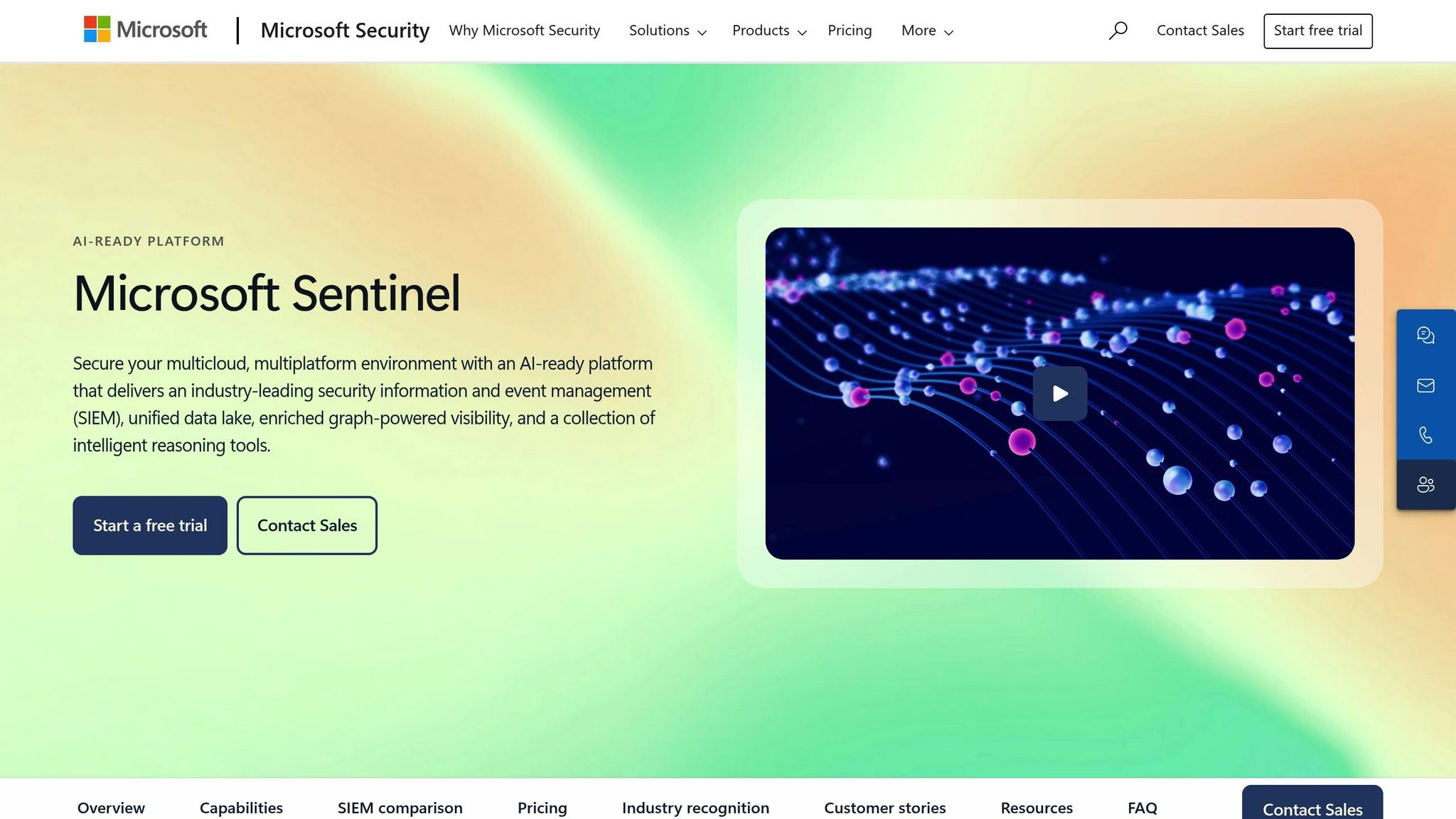
Microsoft Sentinel brings together SIEM, SOAR, UEBA, and threat intelligence within Azure's cloud ecosystem. It processes an astounding 84 trillion security signals daily and benefits from the expertise of over 10,000 security professionals. This unified approach addresses the critical need for platforms that integrate security, interoperability, and automation seamlessly.
At its core, Microsoft Sentinel builds a strong security framework using a unified data lake architecture. This setup centralizes telemetry data and converts it into actionable security insights. Thanks to Azure Monitor's tamper-proofing and immutability features, data integrity is maintained while also allowing for compliant data deletion when necessary.
For workflows powered by AI, Sentinel enforces strict governance measures. These include Entra Agent ID, enhanced protections for personally identifiable information (PII), and adherence to task-specific regulations, making it especially suited for industries with stringent compliance requirements. Recent updates include advanced capabilities in prompt shields, designed to guard against cross‐prompt injection attacks.
Beyond its robust security features, Sentinel excels in interoperability, enhancing its ability to orchestrate across diverse systems. Its Model Context Protocol (MCP) server ensures smooth integration between AI agents - like Security Copilot - and existing security infrastructures. This graph-based system enables agents to analyze complex environments by correlating alerts from various sources and enriching them with contextual data. Sentinel also standardizes AI agent access across Microsoft and non-Microsoft tools, while its REST API framework supports real-time data sharing and custom integrations.
Microsoft Sentinel streamlines operations with automation rules and playbooks built on Azure Logic Apps. These tools enable the platform to handle threat responses automatically, allowing security teams to concentrate on more complex investigations. AI-driven correlations further enhance efficiency by reducing false positives and cutting mean time to resolution (MTTR) by 30%, thanks to Security Copilot integration. The system prioritizes threats based on their impact, adds context to alerts, and executes routine response actions without manual intervention.
Designed as a cloud-native solution, Microsoft Sentinel adapts to organizational growth and increasing threat levels. Its centralized governance framework oversees AI agent activities, automated responses, and resource allocation. To support organizations, especially in the public sector, Microsoft offers specialized blueprints for incorporating generative AI into cybersecurity strategies. These frameworks ensure that AI-driven security practices align with regulatory requirements and maintain operational transparency.

Fortinet FortiSOAR combines automated responses with threat intelligence to secure hybrid environments while maintaining efficiency. Designed to streamline incident response, it offers customizable playbooks and real-time threat correlation, creating a unified approach to managing security workflows.
FortiSOAR employs a zero-trust security model, ensuring that every interaction within its workflows is validated. It maintains detailed audit trails to support compliance with standards like SOC 2, ISO 27001, and GDPR. To further protect sensitive data, the platform includes data loss prevention tools that monitor information flow and enforce role-based access controls, limiting AI agent permissions in line with organizational policies.
The platform integrates directly with Fortinet's FortiGuard Labs, which provides continuous monitoring of security events. This intelligence is fed into its AI-driven decision-making engine, enabling the system to detect emerging threats and adapt responses in real time. For added flexibility, organizations can incorporate their own threat intelligence feeds, tailoring the system to address industry-specific risks and indicators of compromise.
FortiSOAR is built for seamless integration, offering an extensive connector library, support for REST APIs, and webhook compatibility to connect with various security tools, cloud platforms, and enterprise applications. This interoperability extends to AI workflows, allowing the platform to coordinate actions across multiple tools using machine learning insights.
Its bidirectional synchronization ensures that updates to security events and responses are reflected across all connected systems, eliminating data silos and improving visibility during complex incidents. Additionally, FortiSOAR supports standardized data formats like STIX/TAXII for threat intelligence sharing and CEF/LEEF for log normalization, promoting compatibility across diverse environments.
FortiSOAR's automation capabilities reduce manual intervention by leveraging pre-built playbooks for tasks such as phishing response, malware containment, and vulnerability management. These playbooks can be easily tailored through a visual workflow designer that requires no coding expertise. The platform’s AI-enhanced correlation engine processes security events in real time, identifying patterns that signal coordinated attacks or false positives. It continuously improves its accuracy by incorporating feedback from analysts and historical data.
FortiSOAR is designed to handle high volumes of security events, thanks to its microservices-based architecture. This design allows individual components to scale according to workload demands, while load balancing and failover mechanisms ensure uninterrupted performance during peak activity.
The platform also provides a governance framework that gives administrators centralized control over automated processes and AI-driven decisions. Features include approval workflows for high-risk actions, resource limits for automated tasks, and performance monitoring through detailed dashboards. Additionally, FortiSOAR simplifies compliance with built-in reporting tools that generate audit-ready documentation for regulatory reviews and internal assessments.
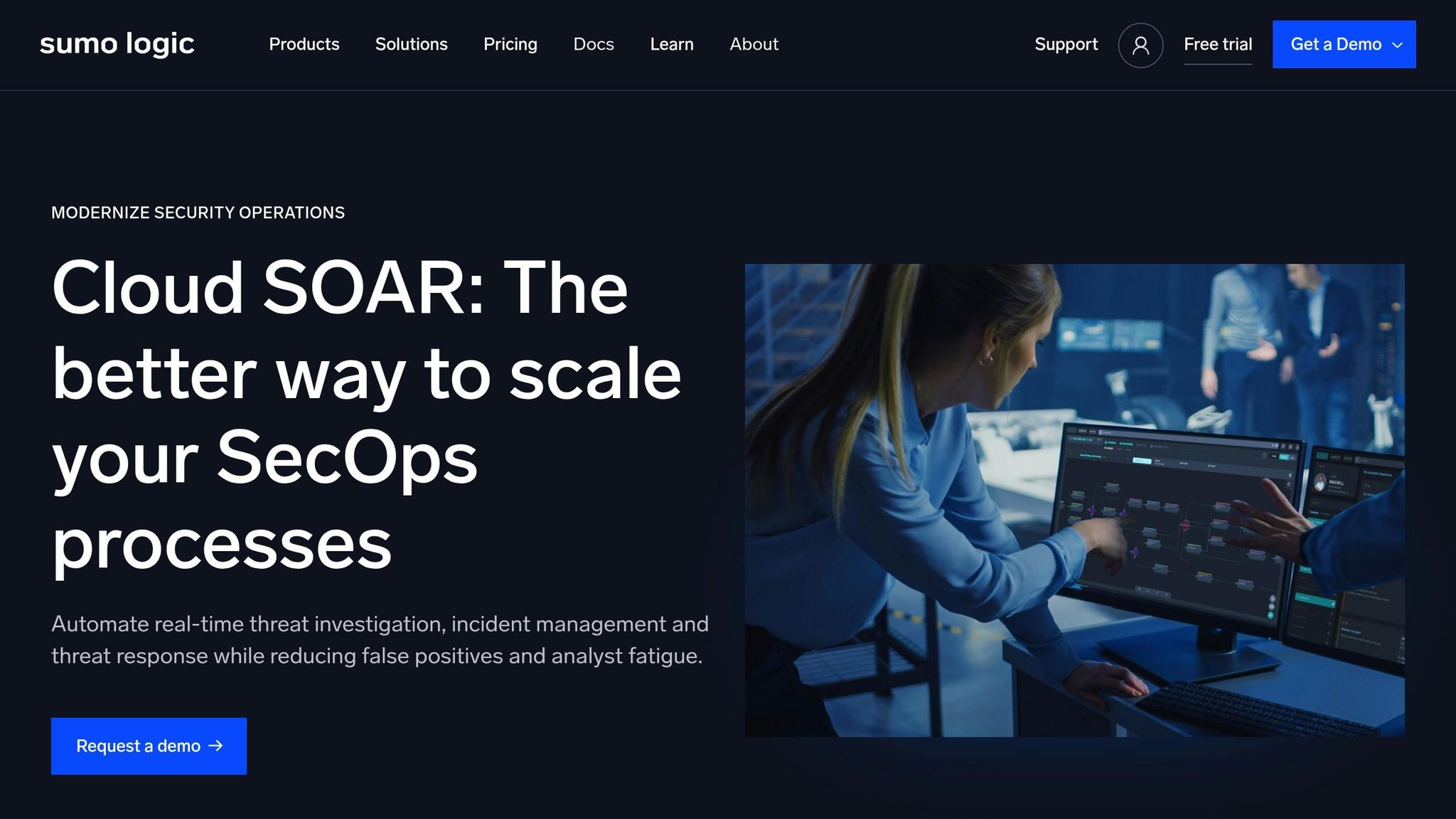
Sumo Logic Cloud SOAR combines cloud-native design, machine learning, and automated incident response to simplify security operations and provide a unified view of your environment.
This platform prioritizes strong security practices, including encryption for both data in transit and at rest, comprehensive audit logging, and role-based access control. It also supports multi-factor authentication and single sign-on, ensuring sensitive information remains protected. By integrating threat intelligence, the system helps keep security policies aligned with the latest risks.
Designed for seamless integration, Sumo Logic Cloud SOAR connects effortlessly with a wide array of security tools and cloud platforms. It features pre-built connectors and allows for custom integrations through RESTful APIs and webhooks. These capabilities enable real-time data sharing across systems, simplifying operations in even the most complex IT environments.
With an intuitive visual playbook editor, teams can deploy automated workflows without needing to write code. The platform includes pre-configured playbooks tailored to common security scenarios, helping to correlate events and minimize false positives. Automated enrichment gathers context from multiple sources, enabling faster, more informed responses to incidents.
Built on a flexible cloud-based framework, the platform scales automatically to handle fluctuating workloads. Centralized governance tools ensure oversight of automated processes and maintain consistent policy application. The analytics dashboard provides actionable insights into workflow performance and resource usage, helping teams optimize operations. These features make Sumo Logic Cloud SOAR a robust choice for organizations seeking to enhance their security operations.
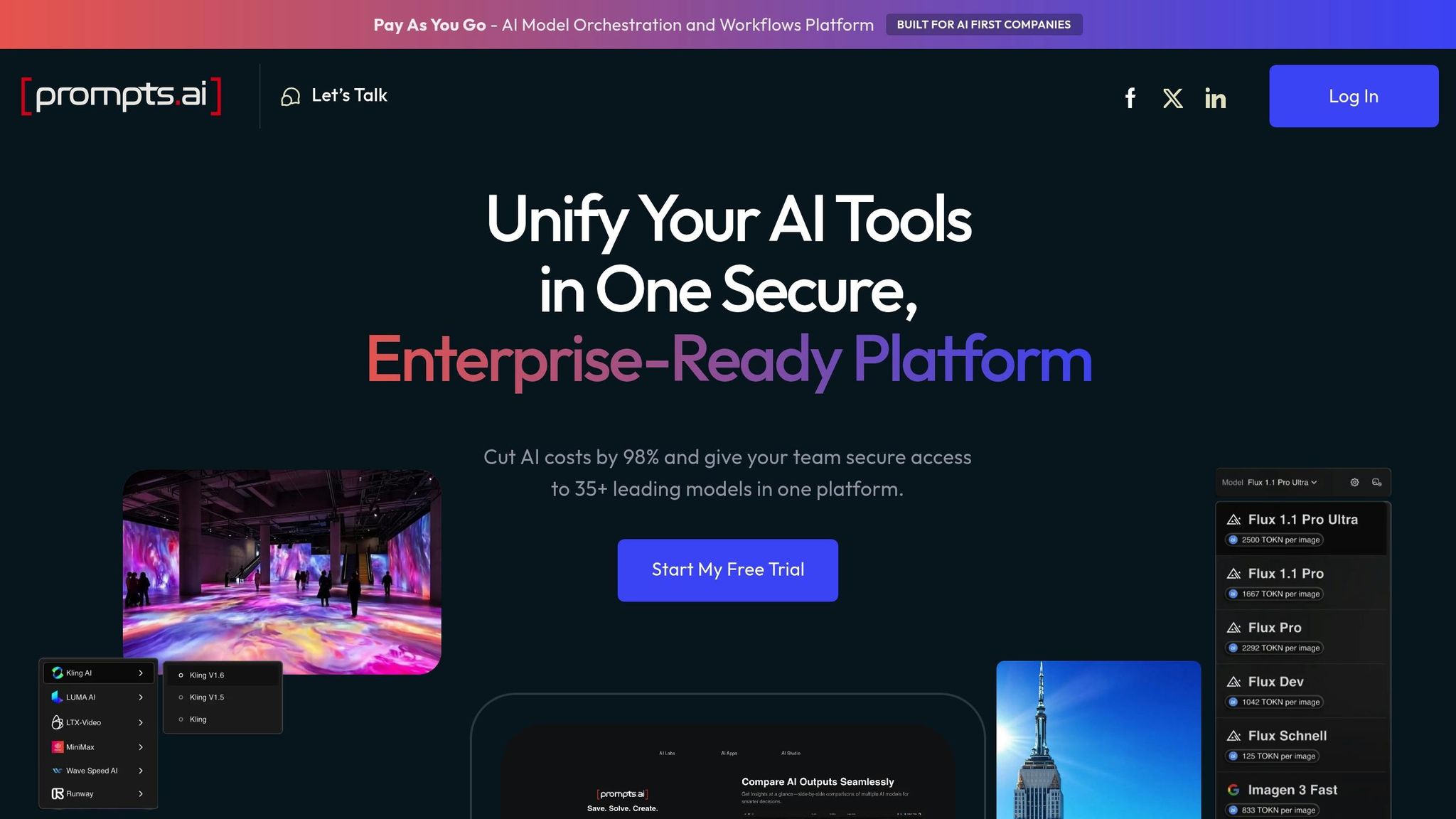
Prompts.ai delivers enterprise-level solutions for managing AI workflows with a focus on governance, cost visibility, and security. By unifying access control and providing clear oversight, it ensures seamless orchestration and secure AI operations.
Prompts.ai prioritizes security by embedding centralized governance and detailed audit trails into every workflow. This approach grants organizations full oversight of team interactions with AI, safeguarding sensitive data through robust role-based access controls and comprehensive audit logs.
The platform also strengthens data protection during AI model interactions. By consolidating access to over 35 AI models within a single secure interface, Prompts.ai enables consistent enforcement of security policies without the need for multiple configuration setups.
Prompts.ai eliminates the complexity of managing multiple tools by integrating more than 35 AI language models, including GPT-5, Claude, LLaMA, and Gemini, into one cohesive system.
Additionally, it seamlessly connects with popular workflow tools like Slack, Gmail, and Trello, enabling automated processes while maintaining strict security measures. This integration ensures smooth collaboration with existing enterprise systems, enhancing operational efficiency.
Prompts.ai simplifies operations by replacing fragmented tools with a unified ecosystem. It offers expert-designed prompt workflows and Time Savers, which allow organizations to deploy secure, repeatable processes. To further enhance automation capabilities, the platform includes a Prompt Engineer Certification program to develop in-house expertise for implementing secure workflows.
This streamlined approach not only boosts efficiency but also aligns with Prompts.ai's commitment to transparent cost management.
Prompts.ai incorporates a FinOps layer that provides real-time tracking of every token used, optimizing costs through its Pay-As-You-Go TOKN credits system. This approach can reduce AI software expenses by up to 98%, eliminating recurring subscription fees that often lead to shadow IT issues.
With real-time cost tracking, organizations gain complete visibility into their AI spending across various teams and projects. This transparency helps tie expenses to specific business outcomes, prevents unauthorized tool usage, and ensures budgets are optimized.
Prompts.ai is designed to scale effortlessly while maintaining stringent governance. Organizations can quickly add models, users, and teams without compromising security or control. Centralized management ensures consistent application of security policies across all AI interactions, regardless of scale.
The platform’s governance framework provides thorough oversight of automated workflows, with built-in controls to uphold security standards as organizations expand. By consolidating over 35 large language models under a single governance structure, Prompts.ai proves especially beneficial for enterprises aiming to scale AI adoption while adhering to strict compliance requirements.
Following the earlier discussion on security and governance, this section dives into how various platforms manage integration and cost, offering a clearer picture of their strengths.
Choosing the right AI security orchestration platform involves balancing security, seamless integration, and cost management. For smooth operations, platforms rely on APIs, connectors, and middleware to ensure uninterrupted data flow.
Some platforms stand out with their integration capabilities and cost strategies. For instance, Splunk SOAR integrates with over 300 third-party tools and supports more than 2,800 automated actions. This robust connectivity allows it to unify security operations, particularly when paired with Splunk Enterprise Security, creating a deeply integrated ecosystem.
On the other hand, Prompts.ai prioritizes a governance-first approach to AI workflow automation. By bringing together over 35 leading AI models into a single secure interface, it simplifies the management of traditionally complex toolsets. Its Pay-As-You-Go TOKN credits system offers real-time cost tracking, aligning expenditures directly with measurable business results. This approach not only enhances governance but also ensures cost efficiency.
While traditional platforms often rely on bundled pricing models requiring significant upfront investment, Prompts.ai provides a more transparent and flexible alternative. Its granular cost structure is designed to adapt to business needs, particularly as platforms evolve to support hybrid and multi-cloud environments. This adaptability is vital for organizations navigating diverse deployment scenarios.
Ultimately, the best platform for your organization depends on your goals. Whether you need comprehensive security orchestration or an AI-centric platform that emphasizes governance, cost control, and streamlined integration, the choice should align with your specific priorities.
Selecting the right AI security orchestration platform means aligning your choice with your organization’s specific requirements, compliance obligations, and future goals. Each solution offers distinct advantages: Cortex XSOAR integrates effortlessly with Palo Alto Networks' ecosystem, Splunk SOAR stands out for its extensive third-party connectivity, Microsoft Sentinel shines with native Azure integration, Fortinet FortiSOAR delivers advanced threat intelligence, Sumo Logic Cloud SOAR provides cloud-native flexibility, and Prompts.ai focuses on governance-driven AI automation with clear cost controls.
For enterprises prioritizing governance and cost-effective AI workflow automation, Prompts.ai offers a compelling option. Its platform consolidates access to over 35 leading AI models within a secure, unified interface. The Pay-As-You-Go TOKN credits system ensures transparent cost management and can cut AI software expenses by up to 98%. This makes it a standout choice for organizations seeking both security and cost efficiency.
When making your decision, weigh critical factors such as threat detection capabilities, automation of responses, ease of integration with your existing systems, compliance with industry standards, scalability to support growth, and the total cost of ownership. These considerations are essential for identifying a solution that not only addresses current challenges but also supports resilience in a constantly changing threat landscape.
Streamlined security orchestration isn’t just about meeting today’s needs - it’s about preparing for tomorrow’s challenges while maintaining robust governance and compliance.
AI-driven security orchestration enhances an organization's defenses by connecting various tools and automating responses to cyber threats. This streamlines intricate workflows, cuts down on manual tasks, and accelerates both threat detection and mitigation.
With AI-powered automation, organizations can tackle incidents as they happen, swiftly contain threats, and limit potential harm. These systems operate based on set protocols, managing risks effectively. This allows security teams to concentrate on higher-level strategies while maintaining consistent and dependable protection.
When choosing an AI security orchestration platform, it’s essential to ensure it works seamlessly with your existing tools and workflows. Compatibility with your current tech setup is key to maintaining smooth operations without unnecessary disruptions.
Look for features like automation of repetitive tasks, improved incident response processes, and better management of threat intelligence. A strong platform should also deliver clear, actionable insights that help speed up decision-making while keeping workflows consistent to tackle security threats effectively.
The ideal platform should meet your organization’s unique requirements, offering practical solutions that strengthen security while improving overall operational efficiency.
The Pay-As-You-Go TOKN credits system offered by Prompts.ai is designed to help organizations keep expenses in check by charging only for the AI services they use. This approach removes the burden of recurring fees and provides greater flexibility, giving you more control over your budget.
To further enhance cost management, the platform features an integrated FinOps layer that monitors every interaction in real time. This tool delivers detailed insights into usage, spending, and return on investment (ROI), ensuring full transparency and empowering businesses to make informed financial decisions for their AI operations.


